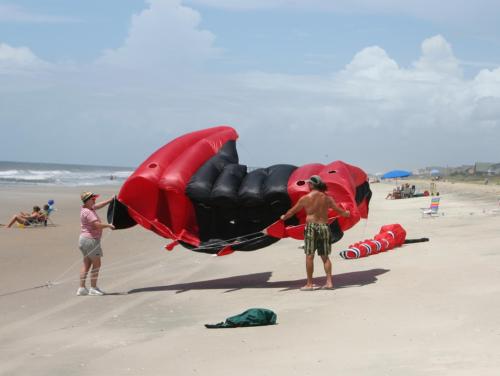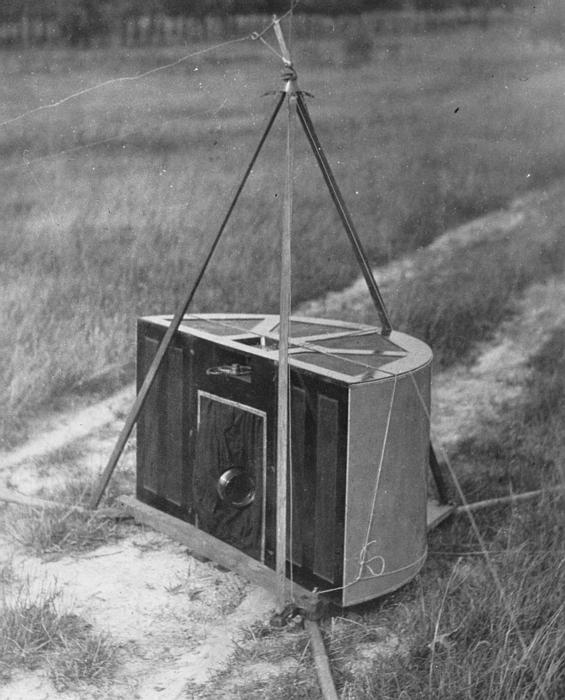1 The camera is not attached to the kite. It is attached to the kiteline. The kite is launched first. We observe th way that it is flying. Check if it pulls enough to lift the camera and if the wind is stable enough for the camera. Then we attach the camera rig to the kiteline. And let more line out.
2 We use a radio transmitter to control the camera and the rig. Yes! the same radio transmitter used for remote-controlled helicopter, airplane, boats and car replicas.
3 Servos. Allows us to pan and tilt the camera and to activate the shutter. Servos are the muscle of the rig. They respond to the radio transmitter allowing us to pan the camera from left to right, right to left; to tilt the camera up down down up; and to activate the camera shutter.
4 Kite aerial photography is OLD. "M. A. Batut took the first kite aerial photographs over Labruguiere, France in the late 1880s. His rig was ingenious. The camera (A) was held near the kite. An altimeter (B) encoded the exposure altitude on the film allowing scaling of the image. A slow burning fuse (C) actuated the shutter a fixed amount of time after the kite was launched (typically a few minutes.) As the shutter released a small flag was dropped to indicate that it was time to haul the kite down. See H. Gernsheim and A. Gernsheim, The History of Photography, McGraw-Hill Book Company, New York, 1969." from http://arch.ced.berkeley.edu/kap/background/history1.html
5 Kite aerial photography can be a lonely practice. As far as I know I'm the only serious kite aerial photographer here in the Philippines. Even if kite-flying is part of our culture. So if you're interested in learning more about kite aerial photography don't hesitate to ask me things.
6 We use big kites. I personally have been able to use a 6ft. wide Delta kite (triangular shape) and a 6.5ft. tall Rokkkaku kite (hexagon shape, piatos shape, japanese fighting kite) for my kite aerial photography works.
6.5 Some use even bigger kites. During the Hot Air Balloon Festival in 2011 at Clark, Pampanga I was able to hang my camera on Sir Orly's huge flowform kite. I think it was about 30ft. wide. Kites like the one on this photo belongs to the category of kites they call soft kites. Soft because they do not have spars and are stiffined by the wind. *Kite by Gomberg. World-known for huge kites. This is just a small one.
7 Some use small cameras. Small simple cameras or small expensive cameras like this kite aerial photography rig by Pierre Lesage featuring a Leica M9.
Check out more of Pierre’s work @: http://www.flickr.com/photos/tahitipix/
Simple point and shoot cameras can also be used for kite aerial phtography. There are also others thatt use GoPro cameras for kite aerial photography.
7.1 Others use bigger cameras. For me, personally I prefer using DSLRs. This photo shows my old kite aerial photography rig with a Nikon D60. I've also used a Sony a35 for my kite aerial photography works.
7.2 Others use even bigger cameras. George Lawrence use a big camera to photograph the famous "San Francisco in Ruins" photograph. The camera weighed 49 pounds (That's the weight of 18 Nikon D4!) and used a celluloid-film plate. The camera was lifted by a train of kites.
2 We use a radio transmitter to control the camera and the rig. Yes! the same radio transmitter used for remote-controlled helicopter, airplane, boats and car replicas.
3 Servos. Allows us to pan and tilt the camera and to activate the shutter. Servos are the muscle of the rig. They respond to the radio transmitter allowing us to pan the camera from left to right, right to left; to tilt the camera up down down up; and to activate the camera shutter.
4 Kite aerial photography is OLD. "M. A. Batut took the first kite aerial photographs over Labruguiere, France in the late 1880s. His rig was ingenious. The camera (A) was held near the kite. An altimeter (B) encoded the exposure altitude on the film allowing scaling of the image. A slow burning fuse (C) actuated the shutter a fixed amount of time after the kite was launched (typically a few minutes.) As the shutter released a small flag was dropped to indicate that it was time to haul the kite down. See H. Gernsheim and A. Gernsheim, The History of Photography, McGraw-Hill Book Company, New York, 1969." from http://arch.ced.berkeley.edu/kap/background/history1.html
5 Kite aerial photography can be a lonely practice. As far as I know I'm the only serious kite aerial photographer here in the Philippines. Even if kite-flying is part of our culture. So if you're interested in learning more about kite aerial photography don't hesitate to ask me things.
6 We use big kites. I personally have been able to use a 6ft. wide Delta kite (triangular shape) and a 6.5ft. tall Rokkkaku kite (hexagon shape, piatos shape, japanese fighting kite) for my kite aerial photography works.
6.5 Some use even bigger kites. During the Hot Air Balloon Festival in 2011 at Clark, Pampanga I was able to hang my camera on Sir Orly's huge flowform kite. I think it was about 30ft. wide. Kites like the one on this photo belongs to the category of kites they call soft kites. Soft because they do not have spars and are stiffined by the wind. *Kite by Gomberg. World-known for huge kites. This is just a small one.
7 Some use small cameras. Small simple cameras or small expensive cameras like this kite aerial photography rig by Pierre Lesage featuring a Leica M9.
Check out more of Pierre’s work @: http://www.flickr.com/photos/tahitipix/
Simple point and shoot cameras can also be used for kite aerial phtography. There are also others thatt use GoPro cameras for kite aerial photography.
7.1 Others use bigger cameras. For me, personally I prefer using DSLRs. This photo shows my old kite aerial photography rig with a Nikon D60. I've also used a Sony a35 for my kite aerial photography works.
7.2 Others use even bigger cameras. George Lawrence use a big camera to photograph the famous "San Francisco in Ruins" photograph. The camera weighed 49 pounds (That's the weight of 18 Nikon D4!) and used a celluloid-film plate. The camera was lifted by a train of kites.





2.jpg)




